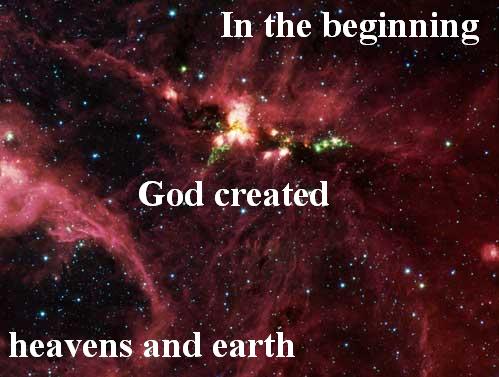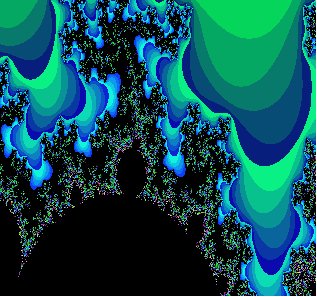
The Bible starts and ends with revelations.
The last book describes future events, and the first one, events that took place a long time ago.

The Bible starts and ends with revelations.
The last book describes future events, and the first one, events that took place a long time ago.
The story of creation, appears to contain several facts that with certainty were unknown,
when the story first was told many thousand of years ago.
This is remarkable, and have important implications.
Like so much else at this web site, this section is under construction.
Eventually I will add more facts.
Until that's completed, I will leave it to you, to think for yourself.
For now, I will restrict myself to looking at the first part of the story.
Let us assume, that someone, several thousand years ago was told how the universe started.
How would that person be able to describe it in the language of that time?
And how much thereof would he understand himself?
To begin with, I will show that such an interpretation is possible.
This does not mean that it has to be correct,
so I will return to that question when the analysis ha been presented.

(The first one who solved Einstein's field equations and predicted the expansion of the universe,
was a priest, Lemaitre.)
Einstein introduced the cosmological constant contact in general relativity,
to make the theory consistent with a universe in which nothing changes (globally).
During the 1950s - and '60s, there were essentially two cosmologies:
George Gamov's theory of the Big Bang (positive curvature, like a sphere),
and Fred Hoyles of a stationary universe (negative curvature, like a saddle).
Both were able to give a reasonable explanation to the expansion of the universe.
In Gamov's theory all matter (or precursors of matter) was created momentarily.
Hoyle postulated a slow creation,
some one hydrogen atom per year in each light year cubic of the universe.
To find the answer, one has tried different methods, among them,
measurements the sum of angles in large triangles.
If this were less than 180 degrees, the universe has a negative curvature
(as a saddle rather than a sphere), and time as well as space would be infinite.
The measurements gave no definite answer.
Rather, discovery of the 3-K radiation was the first step towards finding the correct model.
Such a background radiation is present in Gamov's model, but not in Hoyle's.
The Bible made the correct choice thousands of years ago.
Was that a coincidence?
"...created..."
The Hebrew word 'bara' that is used means create.
It does not say that no material has been used.
On the other hand, it does not say that the universe created from any material that already existed.
Many creation stories tell that the god made the world from something already existing,
e.g. the carcass remaining after he had killed a monster.
The trap has been avoided by the Bible.
Is that a coincidence?
"...the heaven and the earth."
Here the person receiving the revelation faced a dilemma.
The word 'universe' did not exist at that time.
Nor was the concept known.
Therefore, he (or she) had to choose words from the current language.
The largest object one could imagine was a combination of heaven and earth.
So a correct translation today should read:
"In the beginning God created the universe."

"...the deep..."
What is the largest possible depth of a hole?
On Earth, down to the center.
But the surface of the sun is much lower down.
The deepest holes are the black holes, a kind of exotic object present at some locations in space.
Such an object is literally bottomless.
It is a hole not only in space, but also in time.
Such was the newly created universe.
How did the authors of the Bible know that the universe was a deep hole?
"...darkness..."
The dead universe was still too small for visible photons (light particles).
Thus, it was dark.
It was even too small for an atomic nucleus.
But it was as heavy as it is today.
Just imagine of the Earth's mass,
and remember that the earth is just a tiny grain of dust among all celestial bodies.
Later the universe became much larger, but still had to be regarded as dark, as it was not transparent.
The photons were not free, as they are today.
"and the spirit of God moved upon the face of the waters."
The word translated as face, rather means suface.
This could have a significance, but I will not stress that part.
In the fourdimensional space-time, threedimensional space, is a surface growing like a soap bubble.
The text could express the idea that God took care of the delicate fabric of the universe.
This, however is nothing that we are able to verify with our present knowledge,
so we have to leave the idea without any further comments.
The universe was dead.
But the intention was that it would become living - support life.
After an incredibly long time without events (several fractions of a second),
things slowly started to happen.
We should remember that one second then, was a much longer time than millions of years are today.
The universe started to wake up from the heat death.
"...the waters..."
Protons (hydrogen nuclei) and neutrons popped up out of the vacuum.
Here, the author of the story faced one more dilemma:
90 percent of the atoms in the universe are hydrogen atoms.
But the author had no words for such.
The element hydrogen was not known until the 18th century.
When it was found, the chemists named according to its most importand property,
to be the building block that gives water its remarkable properties.
The word hydrogenium means 'the maker of water'.
Genesis' author did the same, he took the existing word in the language that fit best: water.
Therefore, the matter in the universe was described in terms of water.
But how could anyone know that several thousand years ago?


But the Bible speaks of a reverse process, like hydrogen scattered all over the earth was moving to end up in two or more flasks.
This is exactly what happened with the hydrogen from the Big Bang. It moved to form denser and less dense regions. Huge clouds were formed, separated by empty space. The gas clouds split further to form galaxies and then stars. While all this happened, the universe was dark. The second night. After some 100 million years, the stars ignited, and there was the dawn of the second day. Light was back in the universe.
Here is another example of the translators' preconceptions:
Let there be a firmament in the midst of the waters, and let it divide the waters from the waters.
The word 'rakia', translated as firmament actually means something entirely different, expanded space, long range influence, huge space, something reaching far.
A better translation would be:
Let there be expanded void space with a far reaching force field, causing hydrogen to separate from hydrogen.
That is exactly what happened. The one force field in the universe, with infinite range, gravity, caused the gas clouds to spaterate, and empty space to be formed.
But how could anyone describe the events that accurate, thousands of years ago?
Continuation
Translated part ends here temporarily.
Här slutar jag till vidare den detaljerade genomgången och ger bara en kortfattad sammanfattning av resten.

Liksom i raderna ovan, kan man fortsätta att följa Bibelns skapelseberättelse och man finner då att den ena pusselbiten efter den andra faller på plats.
Som helhet kan skapelseberättelsen ses som en fantastisk beskrivning av faktiska händelser och inte alls någon myt.
Trots saknaden av många ord som behövs för att beskriva vad som hände, har författaren lyckats ge en begriplig skildring.
Men inte bara det.
Han/hon har även lyckats utforma berättelsen så att människor flera tusen år senare skulle kunna se att där finns kunskap som har legat dold generation efter generation.
Kan det här vara en gissning från någon forntida människa?
Kan någon ha råkat träffa så rätt utan att verkligen ha fått veta sanningen om universums utveckling från Big Bang och genom årmilliarderna?
En statistisk undersökning visar att chansen är långt mindre än en på millionen.
Den enda rimliga möjligheten är då att skapelseberättelsen har kommit till på övernaturlig väg, genom uppenbarelse i syner eller direkt diktamen från Gud.
Om så är fallet, så är Bibeln Guds Ord och vi står alla inför ett tydligt under.